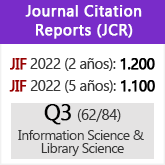Evolución de los factores de posicionamiento web y adaptación de las herramientas de optimización
DOI:
https://doi.org/10.3989/redc.2013.3.956Palabras clave:
Herramientas SEO, optimización en motores de búsqueda, posicionamiento webResumen
Las herramientas de optimización web, Search Engine Optimization (SEO), se utilizan para analizar y mejorar los sitios web en relación a distintos factores de posicionamiento. Esta investigación estudia la evolución de las estrategias de posicionamiento web y analiza la adaptación de las herramientas de optimización a estos factores. Además, se estudian qué factores de posicionamiento están presentes en las herramientas SEO más populares. En la fase experimental se analiza el grado en que las estrategias de optimización mejoran el posicionamiento, y en qué medida se encuentran esas funcionalidades en las herramientas SEO. Adicionalmente se han analizado foros y blogs oficiales para descubrir nuevas pautas de evolución de los motores de búsqueda y el grado en que las herramientas SEO pueden adaptarse a dichos cambios. Aunque estas herramientas optimizan el posicionamiento, los resultados sugieren la necesidad de introducir importantes mejoras que aumenten su potencialidad futura.
Descargas
Citas
Allen, J. (2010). 7 Reasons Why Google Instant Makes SEO Dead-on Relevant. Search Engine Watch. Disponible en: http://searchenginewatch.com/article/2050595/7-Reasons-Why-Google-Instant-Makes-SEO-Dead-on-Relevant [20/11 /2011].
Arbildi, I. (2005). Posicionamiento en buscadores: una metodología práctica de optimización de sitios web. El profesional de la información, 14 (2), pp. 108-124. http://dx.doi.org/10.3145/epi.2005.mar.03
Baeza-Yates, R.; Ribeiro-Neto, B. (2011). Modern Information Retrieval: the concepts and technology behind search. (2ª ed.). Harlow (Reino Unido): Addison Wesley, p. 944.
Brin, S.; Page, L. (1998). The anatomy of a large-scale hypertextual Web search engine. Proceedings 7th International Conf. World Wide Web 7. Brisbane, Australia: Elsevier, pp. 107-117.
Feuz, M.; Fuller, M.; Stalder, F. (2011). Personal Web searching in the age of semantic capitalism: Dianosing the mechanisms of personalitation. First Monday, 16 (2). Disponible en: http://www.uic.edu/htbin/cgiwrap/bin/ojs/index.php/fm/article/view/3344/2766 [7/2/2011].
Flynn, L. J. (1999). Desperately Seeking Surfers. New York Times. 11 noviembre 1996. Disponible en: http://www.nytimes.com/1996/11/11/business/desperately-seeking-surfers.html [20/11/2011].
Gyöngyi, Z.; Garcia-Molina, H. (2005). Web spam taxonomy. Proc. First International Workshop on Adversarial Information Retrieval on the Web (AIRWeb). NY: ACM. Disponible en: http://airweb.cse.lehigh.edu/2005/gyongyi.pdf [12/3/2012].
Hitwise (2008). Google Receives 68 Percent of U.S. Searches in May 2008. Disponible en: http://www.hitwise.com/us/about-us/press-center/press-releases/archived-press-releases/leader-record-growth/ [20/11/2011].
Hitwise (2011). Bing-powered share of searches reaches 30 percent in March 2011. Experian Hitwise reports. Disponible en: http://www.hitwise.com/us/about-us/press-center/press-releases/experian-hitwise-reports-bing-powered-share-of-s/ [11/4/2011].
Karch, M. (2011). Google Bombs Explained: What in the World is a Google Bomb?. Disponible en: http://google.about.com/od/socialtoolsfromgoogle/a/googlebombatcl.htm [8/12/2011].
Kleinberg, J. (1998). Authoritative Sources in a Hyperlinked Environment. J. ACM, 46 (5), pp. 604-632. http://dx.doi.org/10.1145/324133.324140
Kobayashi, M.; Takeda, K. (2000). Information retrieval on the web. ACM Computing Surveys, 32 (2), pp. 144-173. http://dx.doi.org/10.1145/358923.358934
Leighton, H. V.; Srivastava, J. (1999). First 20 Precision among World Wide Web Search Services (Search Engines). JASIS, 50 (10), pp. 870-881. http://dx.doi.org/10.1002/(SICI)1097-4571(1999)50:10<870::AID-ASI4>3.0.CO;2-G
Long, X.; Suel, T. (2003). Optimized query execution in large search engines with global page ordering. VLDB ‘03 Proceedings of the 29th international conference on Very large data bases. Berlin: Morgan Kaufmann, vol. 29, p. 129-140.
Manning, C. D.; Raghavan, P.; Schütze, H. (2008). Introduction to Information Retrieval: Cambridge University Press. Disponible en: http://nlp.stanford.edu/IR-book/ [12/3/2012]. http://dx.doi.org/10.1017/CBO9780511809071
Marchiori, M. (1997). The quest for correct information on the web: Hyper search engines. Proceedings of the Sixth International WWW Conference. Reino Unido: Elsevier, p. 1225-1235. Disponible en: http://www.w3.org/People/Massimo/papers/WWW6/ [20/11/2011].
Miller, M. (2011). Google searches use autocomplete most, ignore Google Instant (eye tracking study). Search Engine Watch. http://searchenginewatch.com/author/2028/miranda-miller [ 28/11/2011].
Morato, J.; Sánchez-Cuadrado, S.; Valiente, M. C. (2005). Análisis de las estrategias de posicionamiento en relación a la relevancia documental. El profesional de la información, 18 (1), pp. 21-29. http://dx.doi.org/10.3145/epi.2005.feb.03
Moreno, V. (2005). Interacción entre medidas de popularidad en el posicionamiento web. El profesional de la información, 14 (2), pp. 100-107. http://dx.doi.org/10.3145/epi.2005.mar.02
Moreno, V.; Morato, J.; Sánchez-Cuadrado, S. (2011). Method and system for estimating the position of a resource. WIPO Patent Application WO/2011/061356.
Pariser, E. (2011). Beware Online ‘Filter Bubbles’. TED 2011 (March). Disponible en: http://www.ted.com/talks/eli_pariser_beware_online_filter_bubbles.html [20/11 /2011].
Rooney, B. (2012). Google Searches for Niche Role in Europe. Wall Street Journal. 23/01/2012.
Singhal, A. (2011). Giving you fresher, more recent search results. The Official Google Blog. 11/03/2011. Disponible en: http://googleblog.blogspot.com/2011/11/giving-you-fresher-more-recent-search.html [3/11 /2011].
Thies, D. (2004). Special Report: How To Prosper With The New Google. SEO Research Labs. Disponible en: http://www.seoresearchlabs.com/seo-research-labs-google-report.pdf [20/11 /2011].
Wall, A. (2006). Search Engine History. Disponible en: http://www.searchenginehistory.com/ [20/11/2011].
Wall, A. (2011). How Search Engines Work: Search Engine Relevancy Reviewed. Disponible en: http://www.seobook.com/relevancy/ [20/11/2011].
Wingfield, N. (2011). Microsoft Fires Back at Google, Calls Copying Claims ‘Insulting’. Wall Street Journal. 3/2/2011. Disponible en: http://online.wsj.com/ [3/2/2011].
Witten, I. H.; Frank, E.; Hall, M. A. (2011). Data Mining: Practical Machine Learning Tools and Techniques. (3ª ed.). Burlington (MA): Morgan Kaufmann, p. 629.
Publicado
Cómo citar
Número
Sección
Licencia
Derechos de autor 2013 Consejo Superior de Investigaciones Científicas (CSIC)

Esta obra está bajo una licencia internacional Creative Commons Atribución 4.0.
© CSIC. Los originales publicados en las ediciones impresa y electrónica de esta Revista son propiedad del Consejo Superior de Investigaciones Científicas, siendo necesario citar la procedencia en cualquier reproducción parcial o total.Salvo indicación contraria, todos los contenidos de la edición electrónica se distribuyen bajo una licencia de uso y distribución “Creative Commons Reconocimiento 4.0 Internacional ” (CC BY 4.0). Puede consultar desde aquí la versión informativa y el texto legal de la licencia. Esta circunstancia ha de hacerse constar expresamente de esta forma cuando sea necesario.
No se autoriza el depósito en repositorios, páginas web personales o similares de cualquier otra versión distinta a la publicada por el editor.

















